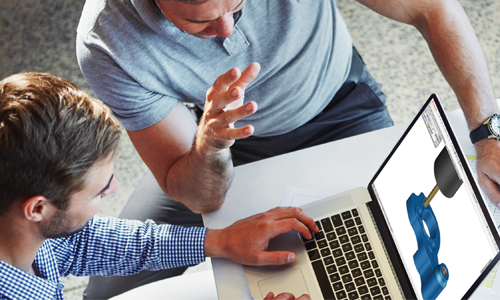How to design and print a perfect 3D model?
That engineer is a special and great profession needs no further explanation. All objects around us were once developed by an engineer. For years we all produced mainly with the well-known techniques such as mill-turning or injection molding. Meanwhile, the 3D printer has made its appearance in the manufacturing industry and this also requires a change in development: designing for a 3D print requires a new way of thinking.
With traditional techniques, development usually starts with a piece of material from which parts are removed until the desired product is achieved. With 3D printing, development begins with an empty space. This empty space is the engineer’s new starting point, as the 3D model is built from layers. What does this mean for the design and printing process?
Making a 3D model
First of all, we require a 3D drawing of the product or part. There are several 3D CAD software packages available for creating the 3D design, like SOLIDWORKS. You can learn how to draw simple models relatively quick, there are various trainings available that teach the basics.
Make it 3D printable
When the 3D drawing is ready, it needs to be converted into a printable 3D file: a so-called .STL file. Several software packages, like Simplify3D, convert 3D drawings into a layer-based model. You basically don’t need to do anything about it, but of course it is possible to adjust some settings to tailor it to -for instance- the material (filament) you’ll be using.
Important aspects to take into account during the design and printing process are:
Thin walls
It sometimes happens that models are scaled to a different size. When scaling down, it could happen that the walls become too thin to be printed. Most 3D printers have a set nozzle (printer head) size with a diameter of 0.4mm. Although this works fine for most models,
problems could arise when layers smaller than the nozzle size need to be printed. When a wall of 0.2mm has to be printed with a 0.4mm nozzle, this thin wall will not be shown in the Simplify3D preview and not be printed. Read more about printing thin-walled products.
Tip: always scale in the CAD program (instead of the slicing software) for the best result.
Support material
Support materials like PVA or PVA+ are often used with 3D printing. These filaments are soluble and enable printing hollow or other complex forms. The angle in which a 3D printer can work without support material is 45 degrees. Every lower angle, so from 0 until 44 degrees, has to be supported. Also when printing for instance a screw thread, support material is required. Read more about printing with support material.
Assemblies
Complete assemblies can be 3D printed in one go, provided that the printer bed is big enough for it. To print an entire assembly, it’s important that the complete assembly is saved as one .STL file.
Bridging
A 3D printer can easily print bridges up to 5 mm. For bridges from 5 to 15 mm, some adjustments in the slicing software are required. The big advantage of printing with plastic filaments, is that it will tighten when it cools down, as the material shrinks a little.
Tolerance
When printing two parts that need to fit together, like a bolt/nut construction, you need to take the shrinking of the material into account. It’s usually enough to use a tolerance of ±0.1mm, but this can differ per model.

